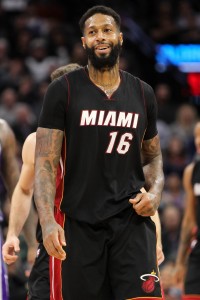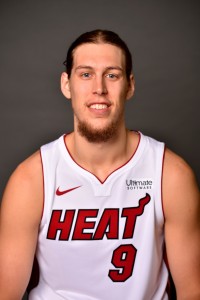Hoops Rumors is breaking down the 2017 offseason for all 30 NBA teams, revisiting the summer’s free agent signings, trades, draft picks, departures, and more. We’ll evaluate each team’s moves from the last several months and look ahead to what the 2017/18 season holds for all 30 franchises. Today, we’re focusing on the Miami Heat.
Signings:
- James Johnson: Four years, $60.002MM. Fourth-year player option.
- Dion Waiters: Four years, $47.3MM.
- Kelly Olynyk: Four years, $45.611MM. Fourth-year player option.
- Jordan Mickey: Two years, minimum salary. Second-year team option.
- Udonis Haslem: One year, minimum salary.
- Derrick Walton Jr.: Two-way contract. One year. $50K guaranteed.
Camp invitees:
- Larry Drew II: One year, minimum salary. Exhibits nine and 10. (Waived)
- Erik McCree: One year, minimum salary. Exhibits nine and 10. (Waived)
- Matt Williams: One year, minimum salary. Summer contract. (Converted to two-way contract)
- DeAndre Liggins: One year, minimum salary. Non-guaranteed. (Waived)
- Tony Mitchell: One year, minimum salary. Non-guaranteed. (Waived)
Trades:
- Acquired A.J. Hammons from the Mavericks in exchange for Josh McRoberts, the Heat’s 2023 second-round pick, and cash ($5.1MM).
Draft picks:
- 1-14: Bam Adebayo — Signed to rookie contract.
Extensions:
- Josh Richardson: Four years, $41.965MM.
Departing players:
- Luke Babbitt
- Chris Bosh (waived; medical retirement)
- Josh McRoberts
- Willie Reed
Other offseason news:
- Purchased a controlling interest in the Sioux Falls Skyforce; will now own and operate the G League affiliate.
- Rodney McGruder to miss three to six months with leg injury.
- Exercised 2018/19 rookie scale option on Justise Winslow.
Salary cap situation:
- Used up cap room. Now operating over the cap, but well under the tax. Carrying approximately $100MM in guaranteed team salary. Room exception ($4.328MM) still available.
Check out the Miami Heat’s full roster and depth chart at RosterResource.com.
Story of the summer:
An annual threat to land the top players on the free agent market, the Heat are an appealing possible destination for stars for a variety of reasons, including the head coach, the management team, the culture, and – not least of all – the climate. As such, it’s no surprise that the front office went after Gordon Hayward this offseason — the All-Star forward wasn’t the best free agent on the market, but he was probably the best one who legitimately considered changing teams.
For the second straight year, however, the Heat secured a meeting with the summer’s top free agent, only to be eliminated from consideration early. A year ago, Kevin Durant passed on the allure of South Beach, and this time around, Hayward’s decision ultimately came down to Utah vs. Boston.
A lack of recent success chasing stars won’t necessarily diminish Pat Riley‘s enthusiasm for pursuing them in future offseasons, but it did force him to change directions this year. Rather than locking up a bunch of players to one-year contracts and rolling over their cap space to the summer of 2018, the Heat made lucrative, long-term commitments to a handful of players after missing out on Hayward.
James Johnson went from a one-year deal worth $4MM to a four-year deal worth $60MM. Dion Waiters, coming off a contract that paid him less than $3MM for one year, inked a four-year pact worth $47MM+. Josh Richardson wasn’t a free agent, but he got a new contract too, signing an extension that will bump his salary from the minimum this year to more than $10MM annually for the next four seasons.
It’s an intriguing strategy for the Heat, one that probably eliminates any chance they had of making a free agent splash in 2018. There are many movable contracts on the roster, so targeting stars on the trade market will still be an option. But Miami’s Plan B this summer suggests that Riley – in the years between legit title contention – is far more comfortable putting together a solid, but unspectacular, roster capable of making the playoffs than he would be blowing things up in search of potential star power in the draft.
Key offseason losses:
The remaining members of the Heat’s Big Three played their final games with the club back in 2015/16, before Dwyane Wade left in free agency and Chris Bosh was sidelined with blood clot issues. However, Bosh technically remained on the roster through the 2016/17 campaign, having been officially waived just this spring. Miami was able to remove his remaining cap hits from the club’s books as a result of Bosh’s medical retirement.
Obviously, the big man’s departure won’t have an on-court impact on the Heat from last year to this year, since he didn’t appear in a single game last season. Nonetheless, Bosh was a significant part of the Heat’s most recent championship teams, and his departure represents the official end of an era in Miami.
As for the departing players who actually played in 2016/17, none are irreplaceable. Willie Reed (5.3 PPG, 4.7 RPG) was a productive backup center behind Hassan Whiteside, and Luke Babbitt (.414 3PT%) was an effective sharpshooter during his lone season with the Heat, but both players only averaged about 15 minutes per game.
The club also parted ways with Josh McRoberts this offseason, bringing his frustrating tenure in Miami to an end. While McRoberts would have been a nice fit for the Heat if he had been able to stay on the court, injuries limited him to just 81 games in three seasons with the organization.
Key offseason additions:
The Heat’s most notable offseason acquisition was big man Kelly Olynyk, whose arrival in Miami was indirectly as a result of the club’s inability to land Hayward. When the Celtics secured a commitment from Hayward, they had to rescind their qualifying offer to Olynyk in order to maximize their cap room. At that point, the Heat pounced on the newly unrestricted Olynyk, agreeing to terms with him just a few hours later.
A former lottery pick, Olynyk was a solid rotation piece in Boston, but even after a memorable performance against the Wizards in Game 7 of the Eastern Conference Semifinals earlier this year, he wasn’t viewed as a marquee free agent. The Heat’s willingness to offer him a four-year contract worth over $45MM was a surprise, and I’ll be curious to see how he fits in the team’s frontcourt alongside Whiteside.
The Heat are a smart franchise, and they’re renowned for an intense conditioning program that helps get the most out of players. If they were eager to bring Olynyk into the mix, I’ll give them the benefit of the doubt and assume they have a vision for how he’ll make the team better.
Outside of Olynyk, the team’s offseason additions were limited. Miami used its 14th overall pick on Bam Adebayo, but he’s an unfinished product at just 20 years old, and is unlikely to play a major role in his rookie season. Elsewhere in the frontcourt, free agent signee Jordan Mickey is more likely to earn a rotation spot than A.J. Hammons, who was a throw-in in a trade with the Mavericks and will likely be first on the chopping block if the Heat need to open up a roster spot.
Outlook for 2017/18:
Despite finishing last season on a 30-11 run, this Heat club almost certainly doesn’t have a 60-win ceiling. It’s a solid roster, and players like Whiteside and Goran Dragic are perhaps borderline stars, but neither of them is equipped to be the best player on a serious championship contender — a playoff appearance is possible and a postseason series win isn’t entirely out of the question, but that’s probably as far as Miami can hope to go in 2017/18.
That’s not bad, but it’s also not the sort of season Riley has grown accustomed to. It will be interesting to see whether he remains patient and sticks with the current version of this Heat team, or if he gets antsy and looks to make a major move or two at this season’s trade deadline.
Salary information from Basketball Insiders used in the creation of this post. Photos courtesy of USA Today Sports Images.